beta-Eudesmol
- CAS NO.:473-15-4
- Empirical Formula: C15H26O
- Molecular Weight: 222.37
- MDL number: MFCD00210502
- SAFETY DATA SHEET (SDS)
- Update Date: 2025-10-29 15:43:00
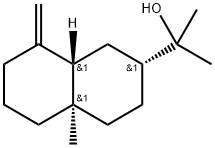
What is beta-Eudesmol?
The Uses of beta-Eudesmol
β-Eudesmol is a sesquiterpenoid molecule that affects the central nervous system (CNS). It is known to induce neurite outgrowth. Antiangiogenic activity.
Definition
ChEBI: A carbobicyclic compound that is trans-decalin substituted at positions 2, 4a, and 8 by 2-hydroxypropan-2-yl, methyl and methylidene groups, respectively (the 2R,4aR,8aS-diastereoisomer).
Properties of beta-Eudesmol
| Melting point: | 72-74 °C(lit.) |
| Boiling point: | 301.7±11.0 °C(Predicted) |
| alpha | +55~+75°(D/20℃)(c=0.2,CHCl3)(after drying) |
| Density | 0.95±0.1 g/cm3(Predicted) |
| storage temp. | Sealed in dry,2-8°C |
| solubility | Chloroform: Slightly Soluble; Methanol: Slightly Soluble |
| form | A solid |
| pka | 15.18±0.29(Predicted) |
| color | White to off-white |
| Odor | at 100.00 %. woody green |
| BRN | 5735560 |
| NIST Chemistry Reference | 2-Naphthalenemethanol, decahydro-«alpha»,«alpha»,4a-trimethyl-8-methylene-, [2r-(2«alpha»,4a«alpha»,8a«beta»)]-(473-15-4) |
| EPA Substance Registry System | 2-Naphthalenemethanol, decahydro-.alpha.,.alpha.,4a-trimethyl-8-methylene-, (2R,4aR,8aS)- (473-15-4) |
Safety information for beta-Eudesmol
Computed Descriptors for beta-Eudesmol
New Products
4,4-Difluoropiperidine hydrochloride tert-butyl 9-methoxy-3-azaspiro[5.5]undecane-3-carboxylate Indole Methyl Resin N-Isopropylurea N,N-Dicyclohexylcarbodiimide(DCC) MELDRUMS ACID 5-METHYLISOXAZOLE-4-CARBOXYLIC ACID Magnessium Bis glycinate Zinc ascorbate 1-bromo-2-butyne 2-acetamidophenol 9(10H)-anthracenone Erythrosin B, 4-Piperidinopiperidine 2-((4-morpholinophenylamino) (methylthio) methylene) malononitrile 2,4-dihydroxybenzaldehyde 3-(4-morpholinophenylamino)-5-amino-1H-pyrazole-4-carbonitrile Methyl 2-methylquinoline-6-carboxylate 2,6-dichloro-4-nitropyridine 4-Bromo-2-chlorobenzonitrile 2-(benzylamino)acetic acid hydrochloride 4-(tert-Butoxycarbonylamino)but- 2-ynoic acid 3,4-dihydro-2H-benzo[b][1,4]dioxepine 1-Phenyl-1-cycloprppanecarboxylicacidRelated products of tetrahydrofuran
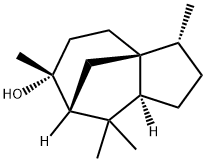

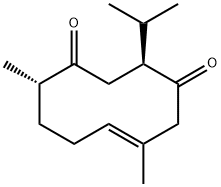
![(1S,3aβ,8aα)-1-Methyl-1α,4α-dihydroxy-4-(hydroxymethyl)-7β-[1-methyl-1-(β-D-glucopyranosyloxy)ethyl]decahydroazulene-2-one](https://img.chemicalbook.in/CAS/20180906/GIF/126054-77-1.gif)

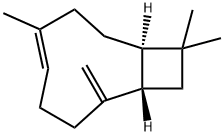

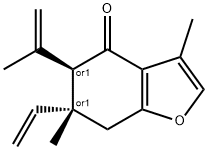
You may like
-
 β-Eudesmol CAS 473-15-4View Details
β-Eudesmol CAS 473-15-4View Details
473-15-4 -
 3-(4-amino-1-oxoisoindolin-2-yl)-1-methylpiperidine-2,6-dione 98%View Details
3-(4-amino-1-oxoisoindolin-2-yl)-1-methylpiperidine-2,6-dione 98%View Details -
 614-19-7 98%View Details
614-19-7 98%View Details
614-19-7 -
 3112-85-4 Methyl phenyl sulfone 98%View Details
3112-85-4 Methyl phenyl sulfone 98%View Details
3112-85-4 -
 20677-73-0 (2,2-diethoxyethyl)methylamine 98%View Details
20677-73-0 (2,2-diethoxyethyl)methylamine 98%View Details
20677-73-0 -
 3-(4-(hydroxyamino)-1-oxoisoindolin-2-yl)piperidine-2,6-dione 98%View Details
3-(4-(hydroxyamino)-1-oxoisoindolin-2-yl)piperidine-2,6-dione 98%View Details -
 57381-49-4 2-bromo-4-chlorobenzonitrile 98%View Details
57381-49-4 2-bromo-4-chlorobenzonitrile 98%View Details
57381-49-4 -
 4,6-dichloropyrimidine-5-carbaldehyde 98%View Details
4,6-dichloropyrimidine-5-carbaldehyde 98%View Details
5305-40-8
Statement: All products displayed on this website are only used for non medical purposes such as industrial applications or scientific research, and cannot be used for clinical diagnosis or treatment of humans or animals. They are not medicinal or edible.
